The BOH Tea Plantation
(thomas;2012-Jul-11)
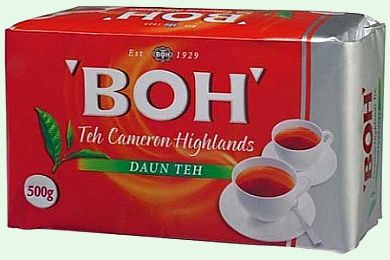 Tea is big business in Malaysia. And BOH is the largest and most well-known tea producer in the country. The company has four main tea plantations, all but one located in the Cameron Highlands region. There are a couple of other companies around, with smaller plantations, but BOH is the 800-pound tea gorilla round there.
Tea is big business in Malaysia. And BOH is the largest and most well-known tea producer in the country. The company has four main tea plantations, all but one located in the Cameron Highlands region. There are a couple of other companies around, with smaller plantations, but BOH is the 800-pound tea gorilla round there.
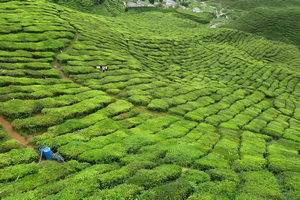 The company was founded in 1929 by a guy originally from Britain named John Archibald Russell (“J.A.”), who was also in the rubber and mining businesses. To this day his descendants are at the helm of BOH: his granddaughter Caroline Russell is currently the CEO. (It seems the letters B-O-H are an abbreviation for “Best Of Highland” — although perhaps this is just a legend.)
The company was founded in 1929 by a guy originally from Britain named John Archibald Russell (“J.A.”), who was also in the rubber and mining businesses. To this day his descendants are at the helm of BOH: his granddaughter Caroline Russell is currently the CEO. (It seems the letters B-O-H are an abbreviation for “Best Of Highland” — although perhaps this is just a legend.)
Once you're up in the Cameron Highlands, it is impossible not to notice the tea plantations. There's one (though not from BOH) south of Tanah Rata, the main tourist village, and a vast one called Sungai Palas (the main BOH plantation) to the north of Brinchang, on the slopes of Gunung Brinchang, with 2032m the highest mountain in the Highlands.
So on a fine day, after we'd climbed this summit via one of the Jungle Walks, we visited that tea plantation which has a modern and well-designed visitor centre. There are all sorts of interesting tidbits (sepia photographs, ancient packaging, old tools and other memorabilia) and also many informative displays about the Cameron region, the tea plant (Camellia sinensis), the BOH plantations and how BOH tea is cultivated, harvested and processed. And of course on the various ways a cuppa can be prepared and consumed.
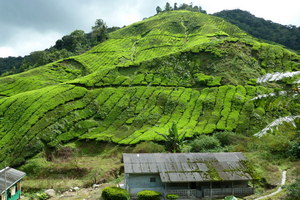 We also walked around the plantation quite a bit: there were rolling hills, some actually pretty steep, with the typical brigthly green tea bushes; there were men cutting the top of the bushes with huge motorised shears (the leaves are collected every three weeks); other men who would lay out the fresh leaves to dry. Indeed, these workers and their families live in the middle of the tea hills, in small clusters of elongated houses with corrugated iron sheets as roofs. Near these houses we invariably would find a makeshift Hindu temple, with a riot of colourful deities: most workers are Indians and they have built their temples in the South Indian style.
We also walked around the plantation quite a bit: there were rolling hills, some actually pretty steep, with the typical brigthly green tea bushes; there were men cutting the top of the bushes with huge motorised shears (the leaves are collected every three weeks); other men who would lay out the fresh leaves to dry. Indeed, these workers and their families live in the middle of the tea hills, in small clusters of elongated houses with corrugated iron sheets as roofs. Near these houses we invariably would find a makeshift Hindu temple, with a riot of colourful deities: most workers are Indians and they have built their temples in the South Indian style.
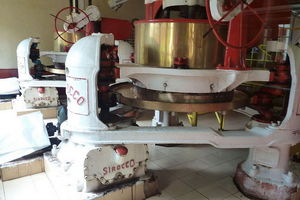 The tea “factory” itself is located behind the visitor centre and it is possible to visit it. The whole process of tea making, starting with drying the leaves to the breaking and fermenting, is explained and can be followed “live” with real machinery on hand. For instance, before fermenting the tea leaves are put into a machine called a roller: this twists and breaks the leaves into small bits so that the fermenting process can work on every part of a leaf. The rollers we saw dated from 1935 (!) and they were pretty impressive machines (named Sirocco, see the photo), still working like a charm.
The tea “factory” itself is located behind the visitor centre and it is possible to visit it. The whole process of tea making, starting with drying the leaves to the breaking and fermenting, is explained and can be followed “live” with real machinery on hand. For instance, before fermenting the tea leaves are put into a machine called a roller: this twists and breaks the leaves into small bits so that the fermenting process can work on every part of a leaf. The rollers we saw dated from 1935 (!) and they were pretty impressive machines (named Sirocco, see the photo), still working like a charm.
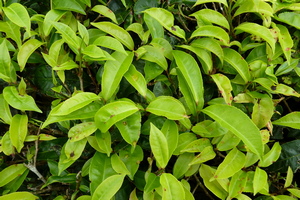 If you're interested in the whole process and some more photos from Sungai Palas there's a web page done by another visitor, with all the details.
If you're interested in the whole process and some more photos from Sungai Palas there's a web page done by another visitor, with all the details.
Of course, we later bought a big pack of BOH tea: we drink a lot of tea during our travels. Normally we'd buy that from the local markets (often, if we can find them, we also buy dried hibiscus blossoms which make a nice evening cuppa) but in this case it was almost mandatory that, being so near to the source, we should buy the real thing!
Want to read more? Go back to Cameron Highlands Jungle Walks or go on to Night Markets and Foodcourts or go up to Blog
$ updated from: Blog.htxt Mon 28 Apr 2025 14:55:32 trvl2 — Copyright © 2025 Vero and Thomas Lauer unless otherwise stated | All rights reserved $



